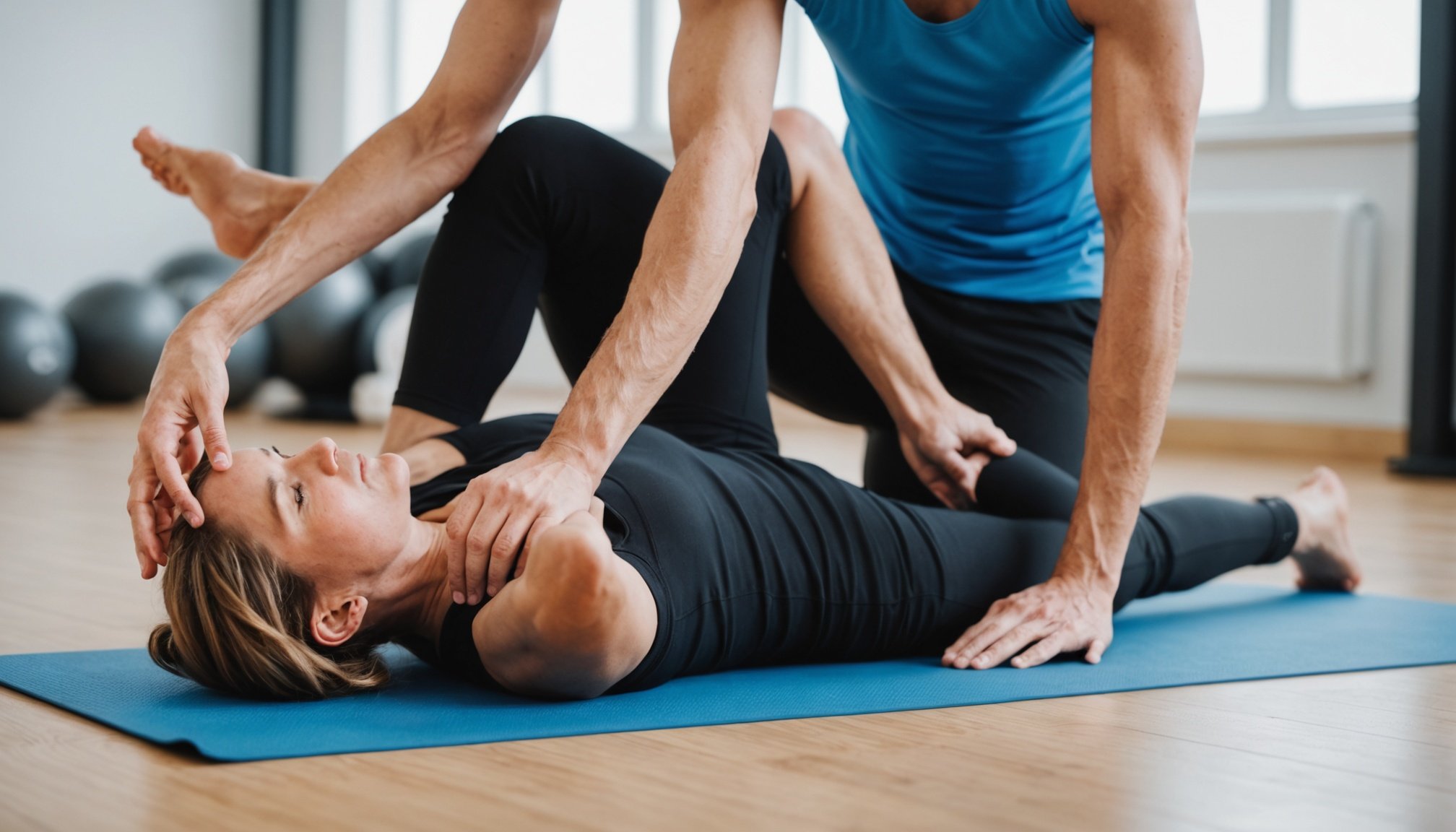Enhancing Athlete Injury Prevention: Innovative Strategies for UK Sports Therapists to Incorporate Yoga
In the fast-paced and demanding world of sports, injury prevention is a top priority for athletes and sports therapists alike. One innovative strategy that has gained significant attention in recent years is the integration of yoga into athletic training. Here, we will delve into the benefits, methods, and practical applications of incorporating yoga into sports therapy, highlighting how this ancient practice can enhance athlete performance and reduce the risk of injuries.
Understanding the Benefits of Yoga for Athletes
Yoga, often misunderstood as merely a flexibility exercise, offers a myriad of benefits that can significantly enhance an athlete’s performance and overall health. Here are some key advantages of incorporating yoga into an athlete’s training regimen:
This might interest you : Revolutionizing Training: The Role of Virtual Reality in the Development of UK Sports Teams
Physical Benefits
- Improved Flexibility and Mobility: Yoga helps in increasing flexibility and mobility, which are crucial for athletes to maintain optimal performance and prevent injuries. Practices like Yin Yoga, for example, target the deeper tissues of the body, such as ligaments, joints, and fascia, which are often affected in sports like football[5].
- Enhanced Strength and Stability: Yoga postures, such as the Warrior 3 pose, improve balance, strength, and stability. These attributes are essential for athletes in various sports, including golf, baseball, and hockey, where balance and precision are key[2].
- Better Body Awareness: Yoga enhances body awareness, allowing athletes to understand their physical limitations and capabilities better. This increased awareness can help in preventing overuse injuries and improving overall physical performance[4].
Psychological Benefits
- Reduced Stress and Improved Mental Focus: Yoga and meditation practices help athletes manage stress and improve mental focus. This is particularly beneficial for athletes who need to maintain a high level of concentration during competitions[5].
- Enhanced Recovery: Yoga aids in recovery by reducing muscle tension and improving circulation. This can help athletes recover faster from intense training sessions and competitions[5].
Integrating Yoga into Athletic Training
To effectively incorporate yoga into an athlete’s training program, sports therapists need to understand how to balance and complement existing training regimens.
Combining Yoga with Other Forms of Training
- Running and Fitness: For runners, combining yoga with fitness training can optimize performance. Yoga helps in improving mobility around the ankles, knees, and hips, reducing the risk of injuries. It also complements cardio workouts by providing an alternative to running, thus avoiding overuse injuries[1].
- Strength Training: Yoga can be integrated with strength training to enhance muscle strength and flexibility. For instance, practices like TRX Yoga combine yoga with suspension training, providing a secure and effective way to strengthen the body after an injury[3].
Tailoring Yoga Practices for Different Sports
Different sports require different types of yoga practices to address specific needs.
Also to discover : Leveraging Drone Footage: Transforming Team Tactics for UK Sports Clubs
| Sport | Yoga Practice | Benefits |
|---|---|---|
| Football | Yin Yoga | Improves flexibility, targets deep tissues around hips and pelvis, aids in recovery and stress reduction[5] |
| Running | Vinyasa Yoga | Enhances cardiovascular health, improves mobility, and reduces the risk of lower extremity injuries[1] |
| Golf | Hatha Yoga | Improves balance, strength, and stability, essential for precise movements in golf[2] |
Practical Strategies for Incorporating Yoga
Here are some practical strategies and tips for sports therapists to incorporate yoga into their athletes’ training programs:
Starting with Basic Postures
- Warrior 3 Pose: This pose is excellent for improving balance, strength, and concentration. It involves standing on one leg while extending the other leg and arm parallel to the ground. Variants using a wall or yoga blocks can be helpful for beginners[2].
Incorporating Yin Yoga
- Butterfly Pose: This pose is beneficial for improving flexibility in the hips and groin area. Athletes sit with their legs extended, then bend their knees and bring their feet together, stretching their hips and lower back[5].
Creating a Balanced Training Schedule
- Alternating Cardio and Strength Training: Athletes should alternate between cardio sessions and strength training to avoid overuse injuries. Including a yoga session once a week can help in maintaining flexibility and reducing muscle tension[1].
Case Studies and Success Stories
Several athletes and sports therapists have seen significant benefits from incorporating yoga into their training regimens.
Callum’s Experience in Football
Callum, a former football player and now a qualified yoga instructor, started practicing yoga to recover from matches and training sessions. He found that yoga improved his flexibility, reduced stress, and enhanced his overall performance. He now recommends Yin Yoga to football players, emphasizing its benefits in targeting deep tissues and improving recovery[5].
Géraldine Lizard’s Adventure
Géraldine Lizard, a fitness coach and adventurous runner, incorporates yoga into her training to maintain flexibility and prevent injuries. She emphasizes the importance of regularity in yoga practice, combining it with fitness and running to optimize her performance and stay injury-free[1].
Overcoming Common Challenges
While incorporating yoga into athletic training can be highly beneficial, there are some common challenges that sports therapists might face.
Initial Resistance
Some athletes may be resistant to trying yoga due to misconceptions about its intensity or effectiveness. It is crucial to explain the benefits clearly and start with gentle, introductory sessions to build trust and confidence.
Finding the Right Type of Yoga
Different types of yoga cater to different needs. For example, Vinyasa Yoga is more dynamic and can be beneficial for runners, while Yin Yoga is more static and suitable for athletes needing deep tissue work. Understanding the specific needs of the athlete and choosing the appropriate type of yoga is essential[5].
Incorporating yoga into athletic training is a holistic approach that can significantly enhance athlete performance while reducing the risk of injuries. By understanding the physical and psychological benefits of yoga, tailoring practices to specific sports, and integrating yoga into existing training regimens, sports therapists can provide their athletes with a comprehensive and effective injury prevention strategy.
Key Takeaways
- Regular Practice: Consistency is key when it comes to yoga. Encourage athletes to practice yoga at least once a week to see noticeable benefits.
- Combination with Other Training: Yoga should be seen as a complement to other forms of training, not a replacement. Balancing cardio, strength training, and yoga can lead to optimal performance.
- Tailored Practices: Different sports require different types of yoga practices. Understanding these specific needs is crucial for effective integration.
By embracing yoga as a part of their training model, athletes and sports therapists can achieve better performance, improved health, and a reduced risk of injuries, ultimately leading to a more successful and sustainable athletic career.
Overview of Yoga’s Role in Injury Prevention
Incorporating yoga into an athlete’s routine can significantly contribute to injury prevention. Understanding the principles that underpin this practice is essential. Yoga focuses on core elements such as flexibility, balance, and strength, which are pivotal in maintaining athlete health. By enhancing these physical aspects, yoga provides a strong foundation for reducing the likelihood of sports-related injuries.
Yoga’s methodology aligns seamlessly with modern sports therapy practices, offering therapeutic benefits that are recognised in current sports medicine. It emphasises mindful movement, which improves proprioception — the body’s sense of movement and position — thereby helping athletes to prevent mishaps during intense physical activities.
Yoga’s preventative effects extend to a variety of common sports injuries. Stretching and strengthening exercises within yoga can minimise strains, sprains, and stress-related injuries. For instance, yoga’s emphasis on core stability can help athletes avoid back injuries, while its flexibility exercises are beneficial in preventing hamstring pulls. Thus, yoga does not just rehabilitate but also proactively shields athletes from enduring certain injuries, fostering long-term athletic care.
Evidence-Based Research Supporting Yoga for Athletes
Delving into yoga research reveals promising findings for athletes, offering both injury prevention and performance enhancement.
Literature Review of Yoga in Sports
Recent literature on yoga research in sports indicates its growing recognition as an evidence-based practice. Studies have consistently shown that yoga can enhance flexibility, balance, and core strength, crucial factors for athletes. Such improvements can lead to a reduction in sports injuries, enhancing the longevity of athletic careers.
Key Findings from Recent Studies
Key findings highlight yoga’s potential in preventing sports injuries through improved bodily awareness and muscle equilibrium. Moreover, the practice’s mental benefits, such as stress reduction and increased focus, contribute significantly to athletic performance. However, some studies point to limitations, such as small sample sizes and evidence-based data inconsistencies. It’s essential for further research to fill these gaps and offer a more comprehensive understanding.
Implications for Sports Therapists
Sports therapists can integrate yoga research insights into their routines, using this evidence-based practice to tailor injury prevention strategies. By applying yoga techniques, therapists can help athletes maintain optimal physical condition and potentially reduce recovery time from sports injuries. This holistic approach could redefine rehabilitation and performance strategies, enhancing athlete well-being.
Innovative Yoga Practices for Injury Prevention
Athletes can greatly benefit from specialized yoga techniques designed to enhance performance and prevent injuries. These practices focus on increasing flexibility and building strength through targeted movements and poses. By integrating these techniques into their routine, athletes can support their body’s resilience and adaptability.
Flexibility training in yoga not only improves range of motion but also aids in muscle recovery. Techniques such as dynamic stretching and holding poses for extended periods can elongate tight muscles and release tension. This is crucial for sports that require agility and quick movements, helping to minimise the risk of strains or sprains.
Therapy options within yoga include the use of props and modifications to accommodate specific needs. These tools assist in safely executing postures while targeting particular areas for strength-building. Poses like Warrior and Triangle are excellent for enhancing core stability and leg strength, fundamental for athletic prowess.
Incorporating breath work and mindfulness, yoga offers a holistic approach to training. Pranayama, or controlled breathing exercises, aids in improving focus and maintaining calm under pressure. Mindfulness practices facilitate mental clarity and concentration, empowering athletes to perform consistently at their best. By adopting these innovative practices, athletes can enjoy a comprehensive, balanced method for injury prevention.
Practical Implementation Strategies for Sports Therapists
Integrating yoga into sports therapy involves thoughtful implementation strategies. This addition serves to complement traditional athletic training by enhancing flexibility, mental focus, and recovery.
Step-By-Step Guide to Incorporating Yoga
- Assess athlete needs and capabilities: Understanding an athlete’s baseline is crucial.
- Select appropriate yoga styles: Choose styles or poses that specifically target identified areas for improvement.
- Create a structured schedule: Integrating yoga into training routine requires consistency to yield tangible benefits.
Developing Customized Yoga Programs for Athletes
Develop a tailored yoga plan by adapting poses to fit the sport-specific requirements. For instance, runners might benefit from poses that improve hamstring flexibility, while swimmers could focus on shoulder and core strength. Emphasise personalised sessions to address individual athlete needs effectively.
Tips for Collaboration with Yoga Instructors
Collaboration is key in merging yoga with sports therapy. Ensure open lines of communication with yoga instructors to clearly convey therapy goals. Sharing insights about an athlete’s progress and needs can lead to more effective sessions. Regular feedback helps fine-tune the programs to sustain benefits, creating a holistic approach to athletic training.
Case Studies and Best Practices from UK Sports Therapists
Successful case studies in UK sports therapy reveal yoga’s growing effectiveness in treatment plans. An athlete with persistent lower back pain saw significant improvement after integrating specific yoga poses tailored to enhance core stability and flexibility. These practices are becoming benchmarks across the industry.
Insights from seasoned therapists highlight both challenges and triumphs. One common struggle is adapting yoga routines to meet individual needs while ensuring safety. Therapists have found success by collaborating with yoga instructors to customise sessions, fostering a holistic and targeted approach to rehabilitation.
There are some best practices for seamlessly integrating yoga into sports therapy. First, ensure you understand each client’s physical capabilities and limitations through comprehensive evaluations. Second, use yoga as a supplementary tool alongside conventional techniques to enhance overall outcomes. Third, maintain an open dialogue with clients about their progress and comfort level with the yoga exercises.
Leveraging these practices helps overcome initial obstacles, enriching the therapy process and providing clients with more well-rounded recovery paths. Additionally, regularly updating skills and knowledge on yoga integration keeps therapists at the forefront of sports therapy innovations in the UK.
Resources for Continued Learning and Training
For those passionate about integrating yoga with sports therapy, numerous resources can propel your professional development. With access to training resources and continuing education, you can enhance your skills and knowledge base.
Recommended Courses and Certifications
Pursuing additional certifications can significantly boost your expertise. Look for reputable programs such as those offered by the Yoga Alliance, where you can attain comprehensive training on therapeutic yoga practices. Courses like “Yoga for Athletes” delve into techniques tailored for sports therapy contexts, offering both foundational and advanced insights.
Online Resources and Communities
Engage with vibrant online platforms where practitioners exchange ideas and experiences. Websites like YogaJournal.com host forums and articles that foster community discussions. These platforms offer a treasure trove of knowledge, ideal for continuous learning and mentorship.
Books and Articles for Further Reading
Expand your understanding by exploring influential literature. Books such as “The Anatomy of Yoga” provide detailed explorations into the physiological impacts of yoga on athletic performance. In addition, articles from journals such as “Journal of Bodywork and Movement Therapies” offer peer-reviewed insights into cutting-edge yoga research relevant to sports therapy.











